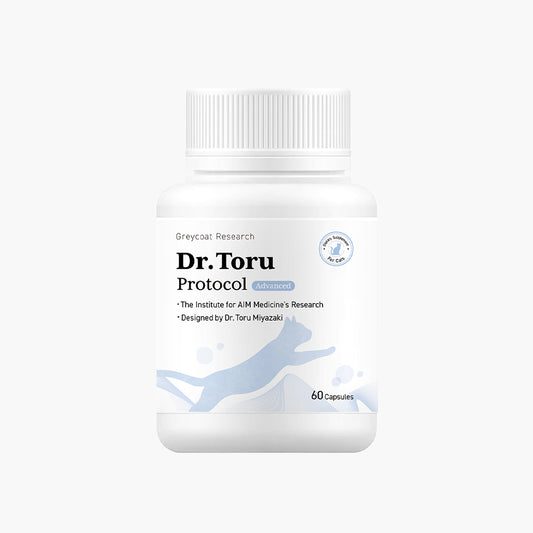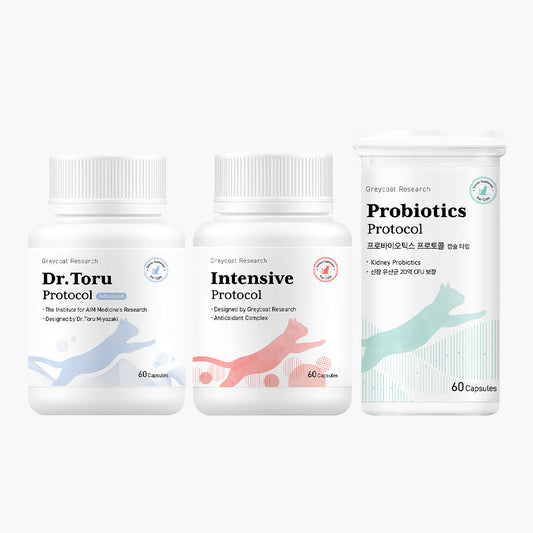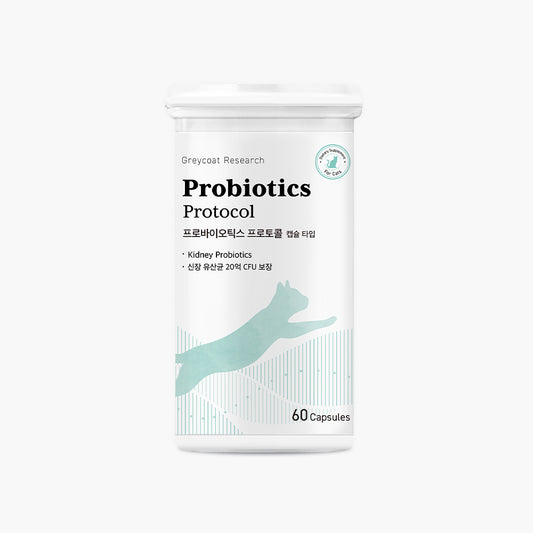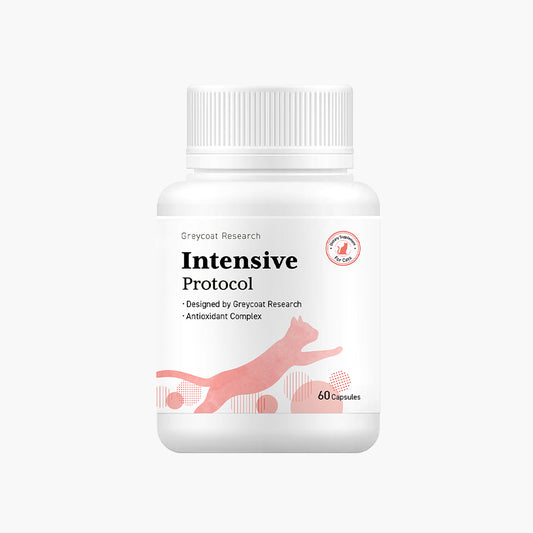
Once a cat reaches stage 3 kidney disease, hidden dangers begin to accumulate in their bodies, long before they appear outwardly.
One of the greatest hurdles to caring for a cat with kidney disease is the fact that they require different care standards and approaches at each stage. While cats with stage 2 kidney disease can often be stabilized through dietary control and hydration, stage 3 marks the beginning of a serious issue: a sharp decline in their body's ability to eliminate waste, electrolytes, and vitamins.
In particular, fat-soluble vitamins A, E, and D3 are not easily excreted, increasing the risk of side effects for cats with stage 3 kidney disease.
This care guide will explain why these 3 vitamins can become dangerous for cats with kidney disease, and why special caution is needed from stage 3 onward.
Greycoat Research: Data-Backed Care for Kidney Cats
Since 2024, Greycoat Research has provided over 1,000 kidney care consultations for cats worldwide. Our approach is based on real-world caregiver data and guided by expert insights:
- Supplement consultations based on research by Dr. Toru Miyazaki of the Institute for AIM Medicine
- Practical guidance from Dr. Kim Jae-young, caregiver of Korea’s oldest cat (Minky, age 28)
- Clinical insights from Dr. Motoo Kobayashi, with 30 years of experience in feline kidney care
- Supplement and fluid therapy tips from clinical pharmacy expert Dr. Shin Yeong-gon
Why Are Vitamins More Dangerous for Cats with Stage 3 Kidney Disease?
Stage 3 kidney disease in cats is defined by creatinine levels of 2.9–5.0 mg/dL, with kidney function reduced to about 25–10% of normal function.
From this stage, the following changes can occur:
- Reduced excretion → buildup of fat-soluble compounds
- Decreased elimination of kidney toxins and inflammatory substances
- Lower nutrient absorption → risk of both deficiency and accumulation
Therefore, when administering supplements, the focus should not just be on "dosage" but on "excretion potential" and "overlap risk."
Vitamin A: A Threat That Builds Up in Livers

Vitamin A can accumulate in a cat's liver and add stress to its detoxification process.
What Does Vitamin A Do?
- Maintains vision cells (prevents night blindness)
- Protects skin and mucous membranes
- Regulates immune function
Why Is Vitamin A Dangerous for Stage 3 Cats?
Vitamin A is an essential fat-soluble vitamin for cats, but for cats with stage 3 kidney disease, both liver and kidney detoxification and excretion functions are impaired.
The matter is further complicated for cats with stage 3 kidney disease due to the following reasons:
- Most cats with stage 3 kidney disease are on anti-nausea drugs, appetite stimulants, phosphate binders, omega-3s, and various supplements
- They are on subcutaneous fluids and low-protein diets, leading to sensitive metabolic states
- Their livers are already under strain from existing detoxification load
If vitamin A accumulates in the liver of cats with stage 3 kidney disease under these conditions, it can lead to liver cell damage, increased liver enzymes, and appetite loss. It may also affect their metabolism of other medications.
In other words, vitamin A adds another potentially dangerous burden to the liver and should be seen not as a simple supplement, but as a substance requiring management.
Symptoms of Vitamin A Accumulation
- Appetite loss
- Weight loss
- Lethargy
- Elevated liver values (ALT, AST)
Tips for Vitamin A Administration
Many multivitamin supplements contain high levels of retinol-based vitamin A. Check for overlapping supplementation, and if unnecessary, eliminate it as the first step in liver protection.
Vitamin E: More Dangerous in Cats with Uremia

Together, uremia and kidney disease can cause gastrointestinal bleeding and anemia to worsen.
What Does Vitamin E Do?
- Protects cell membranes (reduces oxidative stress)
- Supports immune health
- Helps delay aging
Why Is Vitamin E Dangerous for Stage 3 Cats?
Vitamin E, an antioxidant vitamin, is generally beneficial for cats, but stage 3 presents a different picture. At this stage, uremia can damage the stomach lining, making a cat more susceptible to gastrointestinal bleeding.
Most cats already get enough vitamin E through food and treats, so additional supplementation can increase its anticoagulant effects and raise the risk of bleeding-related complications. For cats with kidney disease, bleeding becomes much more difficult to stop and can worsen anemia.
Also, cats with stage 3 kidney disease often have weakened liver and clotting function, so vitamin E accumulation is not just about overdose—it can actively interfere with recovery.
Risks of Vitamin E Accumulation
- Uremia damages GI lining → bleeding
- Excess vitamin E → delayed clotting
- Continued bleeding → worsened anemia
Tips for Vitamin E Administration
Anemia in cats with stage 3 kidney disease is often not just due to iron deficiency, but a complex issue involving bleeding and delayed clotting. As such, cat owners should carefully manage their cat's vitamin E dosage and duration.
Vitamin D3: Dangerous in Deficiency and Excess

Both vitamin D3 deficiency and excess are dangerous for cats with kidney disease.
What Does Vitamin D3 Do?
- Enhances calcium absorption
- Regulates immunity
- Supports nerve function
Why Is Vitamin D3 Dangerous for Stage 3 Cats?
After consumption, vitamin D must be converted by the liver and kidneys into its active form to function properly. The kidney is especially important in converting vitamin D to its final active form, calcitriol.
For cats with stage 3 kidney disease, this conversion becomes inefficient due to their reduced kidney metabolic function, so even with sufficient intake, vitamin D3 effectiveness declines.
This can lead to immune suppression, increased inflammation, and accelerated kidney tissue damage.
Symptoms of Vitamin D3 Deficiency
- Fatigue, appetite loss
- Reduced resistance to infection
- Worsened chronic inflammation
- Accelerated kidney damage
Excess Vitamin D3 Is Also Dangerous
Cats with stage 3 kidney disease struggle to regulate calcium metabolism. Excess vitamin D3 can cause hypercalcemia, soft tissue calcification, and kidney decline.
Tips for Vitamin D3 Administration
Vitamin K2 helps guide calcium to bones instead of soft tissues. If supplementing D3, it should always be paired with K2 to reduce side effect risks.
For Stage 3 Cats, Knowing What to Remove Matters More Than Giving More

Please avoid giving your cat any vitamins that aren't safe for them.
| Vitamin | Why It’s Dangerous for Stage 3 Cats | Risk Management Tip |
|---|---|---|
| A | Accumulates in the liver → detox burden, elevated liver values | Check for overlap; remove if unnecessary |
| E | Uremia + anticoagulant effect → bleeding, worsened anemia | Already present in food; avoid extra supplementation |
| D3 | Deficiency → immune issues; Excess → calcification | Always pair with K2; avoid overdosing |
Cats with stage 3 kidney disease need supplementation, but this is also the stage where improper supplementation can hold immense risks. At this point, both deficiency and excess become serious health risks, so nutritional planning must take into account each vitamin’s function, interactions, and accumulation potential.
Especially with fat-soluble vitamins, even well-intentioned supplements can turn into a “silent toxin” if repeated without careful calculation.
Protect your cat’s condition today, and prepare for tomorrow with better nutritional care. From stage 3 kidney disease onward, eliminating inapprpriate supplements is more important than simply giving more.
Safe Vitamin Supplementation for Cats with Kidney Disease
Excessive intake of vitamins A and E can be dangerous for cats with stage 3 kidney disease. To avoid these risks and still support your cat’s health, choose a safe supplement that avoids unnecessary vitamin overload.
Greycoat Research’s Intensive Protocol contains 23 well-balanced ingredients to support immune and antioxidant functions in cats with kidney disease. It contains no added vitamin A or E, so it can be safely used alongside other renal foods or supplements without the risk of overdose.
Want to find the right care method for your cat? Contact Greycoat Research for a free, personalized consultation today.




